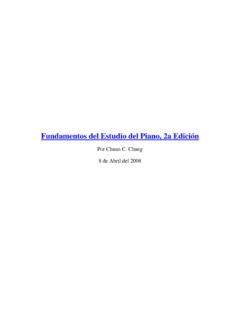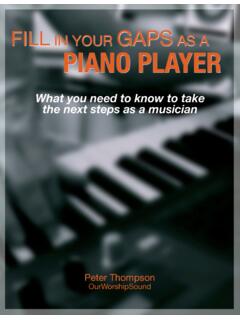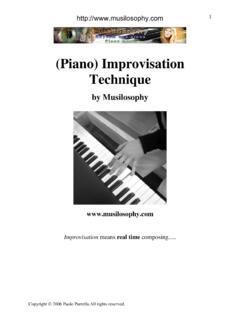Transcription of Fundamentals of Piano Practice
1 Fundamentals of Piano Practice by Chuan C. Chang To my wife Merry and our daughters Eileen and Sue-Lynn The material of Chapter One originated from my notes on how the late Mlle. Yvonne Combe taught our daughters. Mlle. Combe was Debussy's disciple and helped transcribe his new compositions as he played them out on the Piano . She performed that incredible Second Piano Concerto by Saint Saens with the composer conducting. Every audience that attended recitals by her students, especially when they played Debussy and Saint Saens, was mesmerized. This book had to be written: without it, her passing would have deprived this world of a priceless art. Chapter One: Piano TECHNIQUE. Chapter Two: TUNING YOUR Piano . References March 6, 2009.
2 Copyright 2009, copy permitted if author's name, Chuan C. Chang, and this copyright statement are included. ISBN: 1-4196-7859-0. ISBN-13: 978-419678592. Library of Congress Control Number: 2007907498. Order this book at or This entire book can be downloaded free at: 1. Table of Contents Testimonials .. 6. Abbreviations and Frequently Used 14. 16. CHAPTER ONE: Piano TECHNIQUE .. 24. I. INTRODUCTION .. 24. 1. Objective .. 24. 2. What is Piano Technique?.. 25. 3. Technique, Music, Mental Play .. 26. 4. Basic Approach, Interpretation, Musical Training, Absolute Pitch .. 26. II. BASIC PROCEDURES FOR Piano Practice .. 28. 1. The Practice 28. 2. Finger 29. 3. Bench Height and Distance from Piano .. 30. 4. Starting a Piece: Listening and Analysis (Fur Elise).
3 30. 5. Practice the Difficult Sections First .. 31. 6. Shortening Difficult Passages: Segmental (Bar-by-Bar) 31. 7. Hands Separate Practice : Acquiring 31. 8. Continuity Rule .. 32. 9. Chord Attack .. 33. 10. Gravity Drop, Chord Practice , and 33. 11. Parallel Sets .. 35. 12. Learning, Memorizing, and Mental 36. 13. Velocity, Choice of Practice 38. 14. How to 39. 15. Post Practice Improvement (PPI) .. 41. 16. Dangers of Slow Play - Pitfalls of the Intuitive Method .. 42. 17. Importance of Slow Play .. 43. 18. Fingering .. 44. 19. Accurate Tempo and the 45. 20. Weak Left Hand; Using One Hand to Teach the 46. 21. Building Endurance, Breathing .. 47. 22. Bad Habits: A Pianist's Worst 49. 23. Damper Pedal .. 51. 24. Soft Pedal: Hammer Voicing, Physics of the Piano 52.
4 25. Hands Together and Mental Play .. 55. Beehoven's Moonlight, 1st Movement, Op. 27, No. 2 .. 56. Mozart's Rondo Alla Turca, from Sonata K300 (K331).. 59. Chopin's Fantaisie-Impromptu, Op. 66, Fast Play Degradation (FPD).. 61. 26. Summary .. 64. III. SELECTED TOPICS IN Piano Practice .. 64. 1. Tone, Rhythm, Legato, 64. a. What is "Good Tone"? The Basic Keystroke.. 64. Tone: Single versus Multiple Notes, Pianissimo, Fortissimo.. 65. b. What is Rhythm? (Beethoven's Tempest, Op. 31, #2, Appassionata, Op. 57) .. 69. c. Legato, Staccato .. 71. 2. Cycling (Chopin's Fantaisie Impromptu).. 72. 3. Trills & Tremolos .. 76. a. Trills .. 76. b. Tremolos (Beethoven's Pathetique, 1st Movement).. 77. 2. 4. Hand, Finger, Body Motions for 79.
5 A. Hand Motions (Pronation, Supination, Thrust, Pull, Claw, Throw, Flick, Wrist) .. 79. b. Playing with Flat Fingers (FFP, Spider, Pyramid Positions) .. 80. c. Body Motions .. 88. 5. Playing Fast: Scales, Arpeggios, and Chromatic 89. a. Scales: Thumb Under, Thumb Over (TU, TO).. 89. b. The TO Motion, Explanation and Video .. 91. c. Practicing TO: Speed, Glissando Motion .. 92. d. Scales: Origin, Nomenclature and Fingerings .. 96. e. Arpeggios (Chopin's Fantaisie Impromptu, Cartwheel Motion, Finger Splits) .. 98. f. Thrust and Pull, Beethoven's Moonlight, 3rd Movement .. 100. g. Thumb: the Most Versatile 103. h. Fast Chromatic 103. 6. Memorizing .. 104. a. Why Memorize? .. 104. b. Who can, What to, and When to, Memorize.
6 106. c. Memorizing and Maintenance .. 106. d. Hand 107. e. Starting the Memorizing 107. f. Reinforcing the 108. g. Practicing Cold .. 109. h. Slow Play .. 109. i. Mental Timing .. 110. j. Establishing Permanent Memory, Mental Play .. 110. Music 111. Photographic 111. Keyboard memory and mental 112. Theoretical 114. k. 114. l. Sight Readers versus 115. Bach's 2-part Inventions: #1, #8, and #13.. 116. Quiet 120. Sinfonia # 121. m. Human Memory Function; Music = Memory Algorithm .. 122. n. How to Become a Good Memorizer .. 124. o. 125. 7. 126. a. Introduction: Intrinsic, Limbering, and Conditioning Exercises .. 126. Fast vs. Slow Muscles .. 127. b. Parallel Set Exercises for Intrinsic Technical 128. c. How To Use The Parallel Set Exercises (Beethoven's Appassionata, 3rd Movement).
7 134. d. Scales, Arpeggios, Finger Independence and Finger Lifting Exercises .. 135. e. Playing (Wide) Chords, Finger/Palm Spreading Exercises .. 136. f. Practicing 138. g. Stretching and Other 139. h. Problems with Hanon Exercises .. 139. i. Practicing for Speed .. 142. Speed Stroke, 142. Other Speed Methods .. 143. Speed Walls .. 143. 8. Outlining (Beethoven's Sonata #1).. 145. 9. Polishing a Piece - Eliminating 146. 10. Cold Hands, Slippery (Dry/Sweaty) Fingers, Illness, Hand Injury (Carpal Tunnel), Ear Damage (Tinnitus) .. 147. 3. 11. Sight 153. 12. Learning Relative Pitch and Absolute Pitch (Sight Singing, Composing) .. 155. 13. Video Recording and Audio Recording Your Own 159. 14. Preparing for Performances and 160.
8 A. Benefits and Pitfalls of Performances/Recitals.. 160. b. Basics of Flawless Performances.. 161. c. Practicing for Performances.. 161. d. Practicing Musically.. 162. e. Casual Performances.. 163. f. Performance Preparation Routines.. 164. g. During the Recital.. 166. h. That Unfamiliar 166. i. After the 167. 15. Origin and Control of 167. 16. 170. a. Types of Teachers.. 170. b. Teaching Youngsters, Parental Involvement, Mental Play, Absolute Pitch.. 170. How to teach your child.. 172. c. Memorizing, Reading, Theory.. 174. d. Some Elements of Piano Lessons and performance skills.. 175. e. Why the Greatest Pianists Could Not Teach.. 178. 17. Upright, Grand & Electronic Pianos; Purchasing and Care .. 179. a. Grand, Upright, or Electronic?
9 179. b. Electronic 180. c. 183. d. Grands.. 183. e. Purchasing an Acoustic Piano .. 184. f. Piano 185. 18. How to Start Learning Piano : Youngest Children to Old 187. a. Do You Need a Teacher?.. 187. b. Starter Books and 188. c. Beginners: Age 0 to 65+.. 188. 19. The Ideal Practice Routine (Bach's Teachings and Invention #4) .. 191. a. Learning the Rules.. 191. b. Routine for Learning a New Piece.. 191. c. Normal Practice Routines and Bach's 191. 20. Bach: the Greatest Composer and Teacher (15 Inventions and their Parallel Sets).. 197. 21. The Psychology of Piano .. 199. 22. Summary of Method .. 201. IV. MUSIC, MATHEMATICS, AND RESEARCH .. 202. 1. Can We All Be Mozarts? .. 202. 2. Scientific Approach to Piano 203. a.
10 The Scientific 203. b. Principles of 204. 3. Why Is Intuition So Often Wrong? .. 206. 4. Mozart's Formula, Beethoven and Group 206. Mozart (Eine Kleine Nachtmusik, Sonata K300).. 206. Beethoven (5th Symphony, Appassionata, Waldstein).. 209. 5. Learning Rate Calculation (1000 Times Faster!).. 212. 6. Future Research 215. a. Momentum Theory of Piano Playing.. 215. b. The Physiology of Technique.. 215. c. Brain Research, Using the Subconscious.. 215. 4. d. The Future of Piano 217.. e. The Future of ..219. V. JAZZ, FAKE BOOKS, AND 220. CHAPTER TWO: TUNING YOUR 222. 1. Introduction .. 222. 2. Chromatic Scale and 223. a. Mathematics of the Chromatic Scale and Intervals .. 223. b. Temperament, Music, and the Circle of Fifths.










